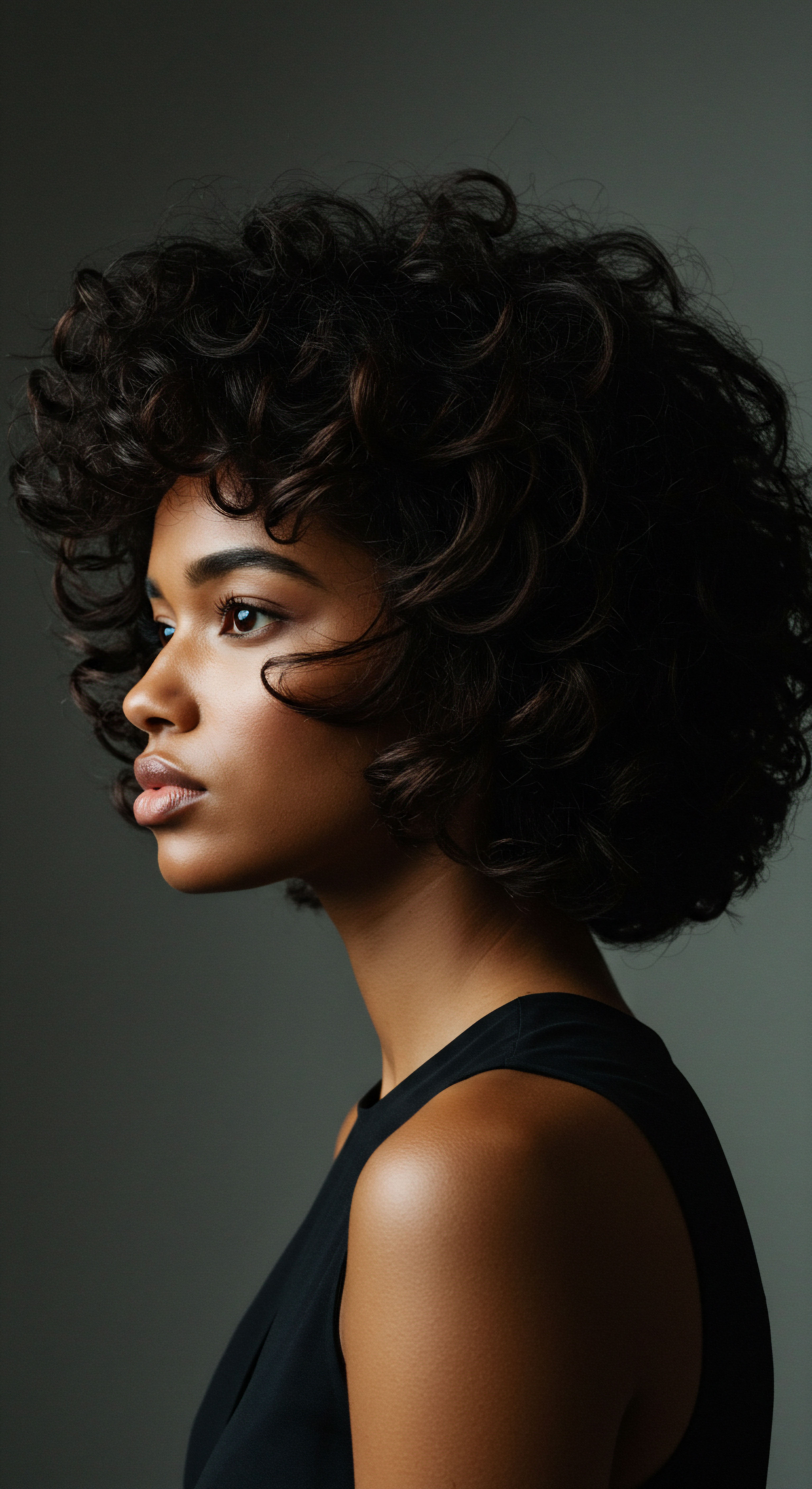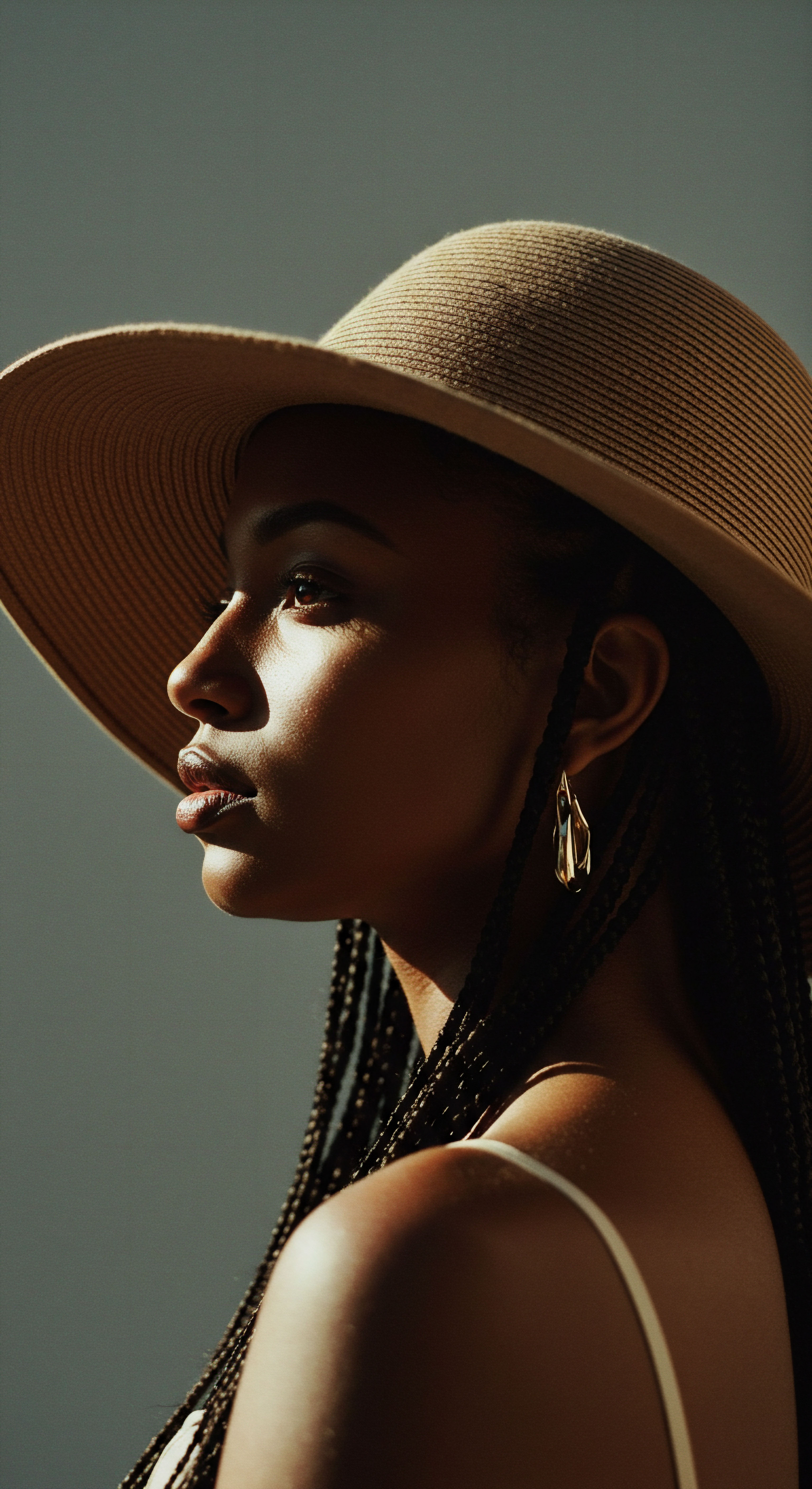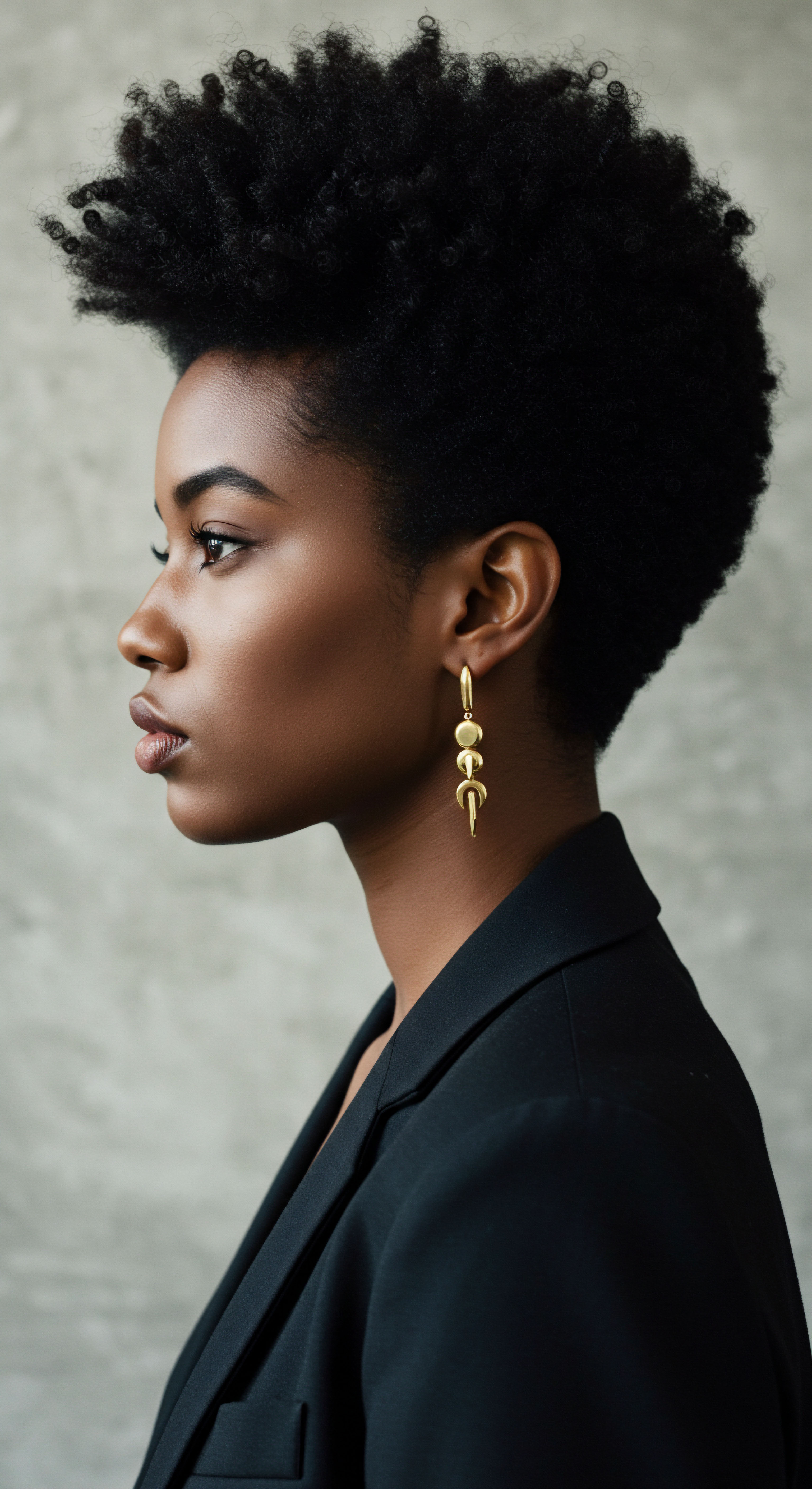
Roots
The whisper of the wind through ancient strands, the resilience of hair against the sun’s persistent kiss, the way dust settled on carefully coiffed coils – these are not merely fleeting images. They represent a deep, enduring dialogue between human ingenuity and the natural world, a conversation spanning millennia. Before the advent of modern laboratories and their synthesized wonders, our ancestors possessed an intimate knowledge of their surroundings, a profound understanding of how to live in harmony with their environment, even as they sought protection from its more challenging aspects. This wisdom extended, with exquisite detail, to the care of hair.
It was a practice born of necessity, refined by observation, and elevated by reverence for the natural order. To truly grasp how historical hair care traditions responded to environmental stressors, we must first look to the earth itself, to the plants, minerals, and elements that formed the bedrock of these timeless practices.

The Earth’s Gifts for Hair Protection
Across diverse landscapes, communities recognized specific botanical and geological offerings that held protective qualities for hair. In arid regions, where the sun beat down with relentless intensity and moisture was a precious commodity, the focus gravitated toward substances that could seal in hydration and shield strands from desiccation. Consider the Himba people of Namibia, whose distinctive reddish coiffures are not merely aesthetic. Their hair and skin are coated with a paste known as Otjize, a mixture of butterfat, ochre, and aromatic resins.
This rich application served as a physical barrier against the harsh desert sun and dry winds, acting as a natural sunscreen and moisturizer. It kept their hair supple, prevented breakage, and maintained scalp health in an unforgiving climate.
Ancient traditions reveal an intimate understanding of nature’s protective bounty, adapting hair care to specific environmental challenges.
Moving to more humid, tropical climes, the environmental stressors shifted. Here, excessive moisture could lead to fungal growth, product buildup, and limp, heavy strands. Traditions in these areas often leaned on ingredients with cleansing and clarifying properties, alongside those that offered lightweight conditioning without adding to the humidity’s burden. The Polynesian cultures, for instance, turned to Coconut Oil, a versatile gift from their abundant palms.
This oil, applied to hair and skin, served as a natural moisturizer and offered a degree of sun protection. Its lighter consistency, compared to heavier butters, suited the moist air, helping to maintain shine and softness without overwhelming the hair.

What Properties Did Plants Offer Hair in Diverse Climates?
The plant kingdom provided an extensive pharmacopeia for hair. In India, the ancient system of Ayurveda integrated herbs like Amla (Indian gooseberry), Neem, and Hibiscus into hair oils and washes. Amla, rich in antioxidants and Vitamin C, was valued for strengthening hair and promoting growth, qualities particularly beneficial in regions prone to intense sun exposure and related damage.
Neem, with its antimicrobial properties, addressed scalp issues common in humid environments, while hibiscus offered conditioning and shine. These botanical elements were not chosen arbitrarily; their efficacy was observed, tested, and passed down through generations, forming a deep body of practical knowledge.
Similarly, in parts of Mexico, particularly in arid and semi-arid regions, the Yucca Root was traditionally used as a natural shampoo and conditioner. Yucca contains saponins, natural cleansing agents that create a gentle lather, effectively removing dirt and environmental debris without stripping the hair of its natural oils, a critical balance in dry conditions. This thoughtful selection of local flora demonstrates a sophisticated grasp of botanical chemistry long before the term “cosmetic chemist” existed.
The relationship between hair, environment, and traditional practices can be organized by climate type:
- Arid Climates ❉ Focus on moisture retention and physical barriers.
- Himba Otjize ❉ Butterfat, ochre, resin for sun and wind protection.
- Castor Oil ❉ Ancient Egyptians used it for growth and texture in desert heat.
- Aloe Vera ❉ Used for hydration in dry regions.
- Humid Climates ❉ Emphasis on lightweight conditioning, cleansing, and anti-fungal properties.
- Coconut Oil ❉ Polynesian cultures used it for moisture, shine, and sun protection.
- Shea Butter ❉ West African communities used it to moisturize and protect hair in hot, dry conditions, with some UV protection.
- Rice Water ❉ East Asian traditions for growth and texture, possibly aiding against humidity-induced limpness.
- Temperate Climates ❉ Balanced approach to protection and nourishment.
- Olive Oil ❉ Mediterranean use for conditioning and shine.
- Herbal Infusions ❉ European traditions using nettle or rosemary for scalp health and strength.
These examples underscore a profound ecological literacy. Communities did not merely react to environmental challenges; they cultivated practices that were intrinsically linked to the biodiversity around them, creating sustainable systems of hair care that honored both personal well-being and the planet’s offerings. The knowledge of which plants to use, how to prepare them, and when to apply them formed an ancestral codex of hair health, passed down through spoken word and lived demonstration.

Ritual
As we step beyond the elemental gifts of the earth, our gaze turns toward the rhythms and practices that transformed raw ingredients into a living tradition of hair care. These were not simply acts of application; they were often deliberate, communal, and imbued with meaning, shaping the way individuals engaged with their hair and, by extension, their environment. The practices themselves became a shield, a balm, and a celebration, moving beyond mere utility to encompass social cohesion and personal well-being.

The Protective Embrace of Historical Hair Practices
Historical hair care traditions often prioritized styles and routines that offered physical protection against environmental elements. Long before chemical straighteners or elaborate heat tools, people utilized braiding, coiling, and wrapping techniques to safeguard their hair. In many West African cultures, intricate braiding patterns served as more than adornment; they were strategic defenses against dust, sun, and tangling in active daily life. These styles kept hair contained, minimizing exposure to environmental pollutants and mechanical stress.
Beyond simple aesthetics, historical hair practices offered practical protection, turning daily care into a shield against the environment.
Consider the meticulous oiling rituals prevalent in many parts of the world, particularly in South Asia and Africa. Hair oiling, deeply rooted in Ayurvedic practices, involved massaging oils infused with herbs into the scalp and strands. This was not just for nourishment; the oil created a protective layer, shielding hair from the sun’s drying rays and preventing moisture loss in hot, arid conditions. This layer also helped to deter dust and environmental particles from settling directly on the hair shaft, making cleansing easier and reducing damage.
The role of protective styling in mitigating environmental stressors is particularly notable in regions with extreme climates. For instance, in ancient Egypt, where the desert climate was intensely dry and dusty, wigs were commonly worn by both men and women across social strata. While wigs served aesthetic and status purposes, they also offered a practical solution ❉ protecting natural hair and scalp from the harsh sun and accumulating sand. Priests, in particular, often shaved their heads and wore wigs, which also aided in hygiene, reducing the risk of lice in a communal setting.

How Did Communal Practices Support Hair Health?
Many historical hair care practices were deeply communal, transforming individual acts into shared experiences that strengthened social bonds and transmitted knowledge. The practice of braiding in Caribbean cultures, for example, often involved women gathering to style each other’s hair. This collective activity provided a space for storytelling, sharing advice, and passing down techniques and remedies through generations. This social context ensured that knowledge about how to care for hair in specific environmental conditions – such as managing humidity – was preserved and adapted.
The preparation of hair care ingredients itself could be a communal ritual. Gathering specific herbs, processing oils, or mixing clay pastes often involved collective effort and shared expertise. This collaborative approach ensured that the efficacy of remedies was continually refined and that the collective wisdom about environmental responses was reinforced. The intergenerational transfer of this practical knowledge meant that each new generation was equipped with time-tested methods for maintaining hair health despite the prevailing environmental conditions.
| Practice Oiling with botanical blends |
| Region/Culture India, West Africa, Mediterranean |
| Primary Environmental Stressor Addressed Sun, Dryness, Dust |
| Mechanism of Protection Creates a protective barrier, reduces moisture loss, prevents breakage, minimizes particle adherence. |
| Practice Protective Styling (Braids, Coils, Wraps) |
| Region/Culture West Africa, Caribbean |
| Primary Environmental Stressor Addressed Dust, Sun, Humidity-induced tangling, Mechanical stress |
| Mechanism of Protection Keeps hair contained, reduces exposure, minimizes friction and breakage. |
| Practice Wig Wearing |
| Region/Culture Ancient Egypt |
| Primary Environmental Stressor Addressed Sun, Sand, Heat, Hygiene |
| Mechanism of Protection Physical barrier, prevents natural hair exposure, aids in cleanliness. |
| Practice Clay/Ochre Pastes (e.g. Otjize) |
| Region/Culture Himba (Namibia) |
| Primary Environmental Stressor Addressed Intense Sun, Dry Winds |
| Mechanism of Protection Physical sunscreen, moisturizer, prevents desiccation. |
| Practice These practices illustrate a sophisticated understanding of hair's needs in varying environmental contexts. |
These practices were not isolated incidents but rather interwoven into the fabric of daily life, reflecting a profound respect for hair as a living part of the body, deserving of deliberate care and protection. The wisdom held within these rituals speaks volumes about humanity’s enduring connection to the environment and the timeless pursuit of well-being.

Relay
Our exploration deepens now, moving beyond the observed practices to the underlying principles and the remarkable scientific intuition that guided historical hair care. This section delves into the intricate interplay of biological, cultural, and environmental factors, revealing how ancient traditions, though lacking modern scientific terminology, often aligned with what contemporary research now confirms. It is a testament to the power of sustained observation and empirical knowledge, passed across generations, adapting and refining itself to the changing environmental pressures.

Hair’s Innate Environmental Defenses
Human hair, at its very core, possesses inherent properties that offer a degree of natural protection. Its primary function, from an evolutionary standpoint, is to shield the scalp from ultraviolet radiation and thermal extremes. The density and curl pattern of textured hair, for instance, create a natural canopy that provides superior UV protection compared to straight hair. This inherent defense mechanism was likely enhanced by traditional practices, creating a synergistic effect.
The chemical composition of hair, primarily keratin protein, also plays a part. Hair is naturally hydrophobic, meaning it repels water. This property, combined with its capacity to absorb certain substances, was intuitively understood and exploited in historical practices. For instance, the widespread use of oils was not only for conditioning but also to create a hydrophobic barrier, reducing water loss from the hair shaft in dry conditions and preventing excessive moisture absorption in humid environments, which can lead to swelling and damage.

Did Ancient Hair Care Practices Foreshadow Modern Environmental Solutions?
Perhaps one of the most compelling, if indirect, parallels between historical hair properties and modern environmental challenges lies in hair’s capacity to absorb oil. While ancient cultures primarily used oils on hair for protection and cosmetic purposes, the very characteristic that makes hair receptive to oils has found a surprising contemporary application in environmental remediation. A study from the University of Technology Sydney revealed that Human Hair and Dog Fur are Highly Effective Biosorbents for Cleaning up Oil Spills, capable of soaking up approximately five times their weight in oil. This unique property, a testament to hair’s natural hydrophobic and absorptive qualities, was recognized by hairstylist Phil McCrory in 1989 after witnessing the Exxon Valdez oil spill.
His observation led to the “Clean Wave” program, where donated hair clippings are repurposed into absorbent booms to contain and clean oil spills. This modern environmental solution, utilizing a material we discard daily, speaks to an intrinsic property of hair that ancient people, through their practical application of oils and protective styling, might have instinctively understood as a means of managing environmental interactions, albeit in a different context.
The deliberate choice of natural ingredients, often locally sourced, further underscores this ecological intelligence. Traditional communities operated within closed-loop systems, utilizing resources that were renewable and biodegradable. This contrasted sharply with the later industrialization of hair care, which introduced synthetic chemicals and unsustainable production methods, leading to new environmental concerns. The very plants and minerals chosen for their protective qualities were part of a sustainable cycle, minimizing ecological impact.
A key aspect of this relay of knowledge involved understanding the impact of dietary and lifestyle factors on hair health, particularly in response to environmental shifts. While not directly “hair care traditions,” these broader health practices certainly influenced hair’s resilience. For example, populations living in regions with limited food diversity, or those experiencing periods of scarcity, might have observed changes in hair quality.
Research on ancient human hair, such as studies by Stephen Macko, professor of environmental science at the University of Virginia, can even reveal dietary patterns of ancient civilizations by analyzing hair clippings. This connection between internal health, external stressors, and hair’s condition was implicitly understood, leading to holistic approaches that addressed well-being as a whole.
The historical understanding of hair’s response to environment can be summarized as:
- Physical Barrier ❉ Hair’s natural structure, especially textured hair, offers intrinsic UV protection.
- Hydrophobic Properties ❉ The natural oiliness and structure of hair repel water, which was enhanced by external oil applications.
- Absorptive Capacity ❉ Hair’s ability to absorb substances, including environmental pollutants or beneficial oils, was utilized for protection.
- Adaptation Through Styling ❉ Styles like braids and wigs physically minimized exposure to elements.
- Holistic Connection ❉ Recognition that overall health, influenced by diet and environment, impacted hair vitality.
The sophistication of these historical traditions lies not in complex chemical formulas, but in a deep, experiential understanding of hair’s biological properties and its relationship with the surrounding world. This ancestral wisdom, relayed through generations, offers compelling insights into sustainable and responsive hair care that remains relevant today.

Reflection
As we close this exploration, a gentle realization settles ❉ the echoes of ancient hair care traditions continue to resonate, inviting us to pause and consider our own relationship with hair and the world around us. These historical practices, born from necessity and refined by wisdom, offer more than mere historical footnotes. They speak to a profound, intuitive intelligence that understood hair not as a separate entity, but as a living part of us, deeply connected to the rhythms of nature. In a world increasingly shaped by environmental shifts, perhaps the true legacy of these traditions lies in their quiet insistence on harmony, on seeking solutions not in complex concoctions, but in the enduring gifts of the earth and the timeless wisdom of thoughtful, deliberate care.

References
- Biddle-Perry, Geraldine. A Cultural History of Hair ❉ Volumes 1-6. Bloomsbury Academic, 2019.
- Byrd, Ayana, and Lori Tharps. Hair Story ❉ Untangling the Roots of Black Hair in America. St. Martin’s Press, 2001.
- Sherrow, Victoria. Encyclopedia of Hair ❉ A Cultural History. Greenwood Press, 2006.
- Stenn, Kurt. Hair ❉ A Human History. Pegasus Books, 2016.
- Weitz, Rose. Rapunzel’s Daughters ❉ What Women’s Hair Tells Us about Women’s Lives. Farrar, Straus and Giroux, 2004.
- Koch, Sandra L. et al. “The biology of human hair ❉ A multidisciplinary review.” American Journal of Human Biology 32.2 (2020) ❉ e23316.
- González-Elizondo, Martha S. et al. “Ethnobotany in Rayones, Nuevo León, México.” Journal of Ethnopharmacology 113.2 (2007) ❉ 293-301.
- Nwafor, Obianuju E. et al. “Cosmetopoeia of African Plants in Hair Treatment and Care ❉ Topical Nutrition and the Antidiabetic Connection?” Diversity 16.2 (2024) ❉ 96.